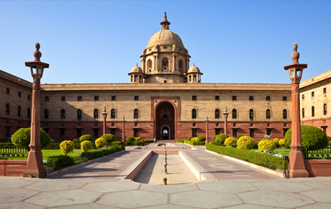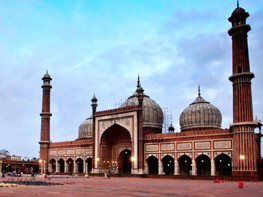

Delhi Tours
Delhi, one of India's fastest growing cities, has spread far beyond the "seven cities" created between the 13th and the 17th centuries. It has sprawled over the west bank of the Yamuna and now straddles the river. Remnants of the past survive cheek-by-jowl with skyscrapers, residential colonies and bustling commercial complexes. Delhi has some of the finest museums in the country. Its boutiques and shopping arcades offer access to a wealth of traditional and contemporary crafts from all over the country. It has speciality restaurants to please the gourmet, open parks and gardens ablaze with flowers, and in the winter months particularly, a variety of cultural events. Its many-layered existence is tantalizing and can entice the curious traveller into a fascinating journey of discovery.

The history of this centre of power dates to the first millennium BC. In 1955 excavations within the Purana Qila revealed that the area was inhabited more than 3000 years ago. This was Indraprastha, a site associated with the epic Mahabharata.A clearer picture emerges at the end of the 10th century. The Tomar Rajputs built Lal Kot, the core of the first of Delhi's seven cities. Later, another Rajput king, Prithviraj Chauhan - hero of ballads and legends - extended it to create the Qila Rai Pitbora. In 1206, Qutb ud din Aibak, a slave of Mohammad of Ghor crowned himself the Sultan of Delhi and occupied the Rajput fort. He commemorated his victory by building the Quwwat ul Islam mosque. It is the earliest extant mosque in India and within its courtyard stands the 4th-century standard of Lord Vishnu, the famous, uncorroded Iron Pillar. Nearby, he raised the towering minaret, the Qutb Minar, one of Delhi's landmarks. Other architectural gems within this complex include the tomb of Illtutmish and the Alai Darwaza.
Around 1311, Allaudin Khilji established Siri, the second city and dug a vast reservoir at Hauz Khas. Very little remains of Siri, but Hauz Khas was extensively renovated a few decades later. Now, ethnic boutiques and cafes dot the Hauz Khas village and the location is as attractive as the exclusive goods on sale.
The great fort of Tughlaqabad was raised in 1321 as a protection against Mongol raids and became Delhi's third city. The fort and tomb are characteristic of robust Tughlaq architecture. Delhi's fourth city, Jahanpanah has practically disappeared but its fifth, Firoz Shah Kotla rises off Bahadur Shah Zafar Marg and is well known for its Ashokan pillar which the Sultan brought from Mathura. Timur devastated Delhi in 1398 and as a result the 15th century saw little growth. The tombs of the Lodi kings date to this era and are within the landscaped Lodi Gardens, one of Delhi's most beautiful gardens.
In 1526, Babur founded the Mughal empire in India. The impressive Purana Qila , Delhi's sixth city, is a combined effort of his son Humayun and the Afghan Sher Shah Suri who temporarily deposed him. The fort contains a fine mosque and what was possibly a library. Nearby are the Zoo, the Crafts Museum, where craftsmen work in a simulated rural setting, and Pragati Maidan, the exhibition grounds. The magnificent tomb of Humayun, which is a precursor to the Taj Mahal is 2 km from here.
In Apiil 1639 the Mughal emperor Shah Jahan laid the foundation of Shahjahanabad, Delhi's seventh city, and it epitomised the grandeur of his empire. This walled city has since been continuously inhabited. It is one of the most densely populated localities in the world and it retains a unique vitality and charm. The Red Fort, Shah Jahan's sandstone citadel encompasses grand audience halls - where the legendary Peacock Throne once stood - and marble palaces ornamented with exquisite pietra dura. Opposite the Red Fort is the Jama Masjid, India's largest mosque.
For the intrepid traveller there is rnore... Chandni Chowk, the moonlit square, is adjacent to the mosque, and leads to the heart of the walled city. This was once a tree-lined bazaar with a canal flowing through its centre. Today, it is one of the largest trading centres in northern India - thriving, congested and chaotic. Chandni Chowk is replete with historical landmarks and each of its bylanes leads into a world of spices or silver or perfumes or textiles.....

New Delhi was built in 1911. It was to be "conceived with spaciousness and care so that the new creation would be in every way worthy of this ancient and beautiful city". Lutyens and Baker planned a city with wide, tree-lined avenues. The 340-roomed Viceregal Lodge, now the Rashtrapati Bhawan, was raised on Raisina Hill. Nearby are India Gate, a World War I memorial. Parliament House, the prestigious National Museum and the National Gallery of Modern Art. On Republic Day, Rajpath witnesses a display of pageantry.
The classy commercial centre of Connaught Place was planned as part of New Delhi. Alongwith stalls on Janpath, and emporia on Baba Kharak Singh Marg, it is a shopper's paradise. Rather characteristically, an 18th century masonry observatory, the Jantar Mantar, lies in the midst of this commercial area.
But there is still more to Delhi... Art galleries and theatres and a variety of museums... memorials to leaders... Hindu, Sikh, Buddhist, Jain and Bahai temples- folk dancers, discotheques, urban villages- even birdwatching along the ridge. Come discover a country through a city.
General Information :
- Area : 1483 sq kms
- Altitude : 239 m above sea level
- Population : 9,370,475
- Males : 5,120,733
- Females : 4,249,742
- Literacy Rate : 76.1%
- Languages : Hindi, Punjabi, Urdu, English
Climate : The city has an extreme climate. December and January are chilly with night times lows of 4 °C. The city has spring months in February and March. The summer months of May & June are scorchingly hot with mercury soaring to a high of 46 °C. The city does not have much of rainy season. The monsoon lasts from July to September.

